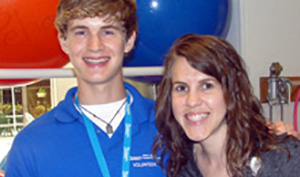Dale: Epidural Hematoma (Traumatic Brain Injury)
“It’s so exciting to see him volunteering in the hospital, especially when he’s helping in the same gym where he spent months working hard himself. He’s been quite an inspiration to all of us.”
– Maura McManus, MD, Chief of Physical Medicine and Rehabilitation at Nemours Children’s Hospital, Delaware

A Young Life Restored
In March 2011, Dale was an athletic 16-year-old high school sophomore trying out for an American Legion baseball team. During one particular drill, the ball took a unexpected bounce off the grass and shot up into the side of his head, right around his temple. He finished the drill, but his head began to hurt — and it continued to feel worse. When he got home, his mother took him to get it checked out at the local hospital. That turned out to be a lifesaving idea.
While he was at the hospital, Dale lost consciousness. A CT scan showed bleeding in his head. In fact, a piece of his skull had actually been broken and pushed inwards where it cut into an artery. Within minutes, Dale was on a helicopter to Nemours Children’s Hospital, Delaware.
The resulting condition is called an epidural hematoma, a type of traumatic brain injury (or TBI) in which a buildup of blood occurs between the outer membrane of the brain and the skull. This can exert dangerous pressure on the brain’s delicate tissue. It can even be deadly (15–20 percent of them are), since the bleeding is from an artery. It’s vital to have surgery to stop the bleeding within six to eight hours after the injury, so Dale’s mother was told that he’d need immediate brain surgery.
The procedure Dale underwent is called a craniotomy, during which a piece of bone is temporarily removed from the skull to access the brain. Nemours neurosurgeon Jeffrey W. Campbell, MD, sealed the artery and re-set his broken skull.
Making the Long Journey Back
After his surgery, Dale was in a coma for a week. Another week or so after regaining consciousness, he began the long and challenging journey toward recovery. He needed to regain his ability to speak, move and think at pre-injury-like levels. To do this, he was going to need help of an array of experts. His care was led by Nemours rehabilitative medicine physicians, including Maura McManus, MD, chief of Physical Medicine and Rehabilitation (Rehabilitation Medicine). Dale’s team also included specially trained speech, physical and occupational therapists.
Dale remained an inpatient for two months; his therapy continued on an outpatient basis for another four months. He worked hard in the rehab gym, often with physical therapist Heather Gonzalez, DPT, CBIS (Doctor of Physical Therapy, Certified Brain Injury Specialist).
“Dale made my job easy,” says Gonzalez, “because he was such a motivated and active participant in his recovery. It was exciting to see how quickly he progressed as a result of his cheerful dedication. He did anything I asked of him, and he did it with a big smile on his face.
One interesting therapeutic technique the care team used involved an interactive metronome. Dale held a sensor in one hand and had to clap it with his other hand as soon as he heard the sound. This helped to improve his reflexes and reaction time.
Through it all, Dale made great strides. He recovered much of the ground he’d lost, and returned to the activities he loved, including the high school drum line. He even played baseball again just one year after his initial team tryout.
Inspirational Care Leads to a Career
From his experience, Dale was inspired to become a summer high school volunteer at the hospital. "This hospital has done so much for me,” he says. “I’m so thankful for the care I received from the docs, the therapists and everyone in the rehab gym, plus the nurses on 2A. I just want to give back whatever I can."
Dr. McManus is proud of — and happy for — Dale. “He was the ideal rehab patient. He worked hard every day, cooperated with the nurses and therapists, and stayed motivated and pleasant throughout his entire rehab program. Through Dale’s determination and his family’s support, he has made a tremendous recovery. It’s so exciting to see him volunteering in the hospital, especially when he’s helping in the same gym where he spent months working hard himself. He’s been quite an inspiration to all of us.”
Dale has also been inspired from the rehab professionals at Nemours — Gonzalez in particular. He explains, “She actually made my therapy entertaining and something I looked forward to. I always thought some area of medicine would be interesting. A few months into my rehab process, I knew this is what I wanted to do with my life.”
And so, Dale’s journey continues — he’s been accepted to a six-year, college-level physical therapy program. Thanks to a wayward baseball, his single-minded recovery efforts and the dedicated care team at Nemours, Dale is going to be a physical therapist.


